Trinity College Dublin is the oldest university in Ireland. It was created by Royal Charter in 1592, at which point Dublin Corporation provided a suitable site, the former Priory of All Hallows, an Augustinian house which was founded by Dermot Mc Murrough in 1166 and which survived until its dissolution under Henry VIII in the 1530’s. Queen Elizabeth I said Trinity College was to be for “the education, training and instruction of youths in the study of liberal arts and in the cultivation of virtue and religion”. Trinity College has the largest library in Ireland and is home to the famous Book of Kells.
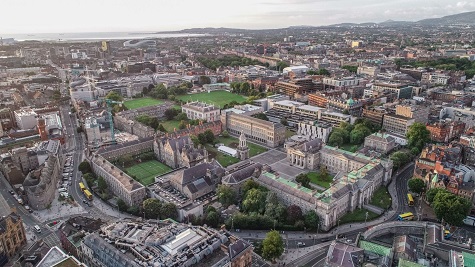
Aerial view of Trinity College Dublin. Photo courtesy Trinity College
In the days before Covid-19, when people could wander freely through the campus to marvel at the buildings and grounds, and not to mention its historic significance, one would expect that it took very little to maintain the grounds there. To say that there are only a couple of pitches and some lawns here and there - nothing could be further from the truth.
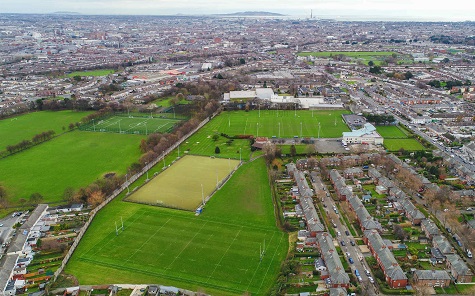
An aerial view of the Iveagh Grounds showing the various sports facilities. Photo courtesy Trinity College
The College is maintained by Estates & Facilities (E&F) who maintain the University’s energy supply and utility infrastructure, provide facilities support and provide a wide-range of engineering and technical services. E&F is responsible for the planning and development of the university’s buildings and sites and for the operation and maintenance of the university’s buildings, sites and facilities. Overall over 400 staff are employed directly by E&F. The college is maintained through a blend of skilled in house labour and strategic external service partners.
There are 18 campus maintenance operatives, which includes three craft gardeners who are responsible for the maintenance of the grounds. Tony Dalton is the Campus Maintenance Manager who looks after the general running of the Department, with the technical backup coming from John Parnell who is the Craft Gardener Team Leader and David Hackett who is the Environmental Services Coordinator. David manages the day to day maintenance and planting programme of the tree collection and carries out the tree risk assessments and the 5 year tree survey. The campus maintenance operatives keep the grounds in immaculate condition and the craft gardeners who started three years ago have significantly added to the range of plant bio-diversity on the grounds. David forms part of the Technical Services Division, while Tony and John are part of The Campus Maintenance division. Each team within E&F regularly liaises with each other as there is a crossover of work between them, good communication is key to the successful running of the operation of the College.
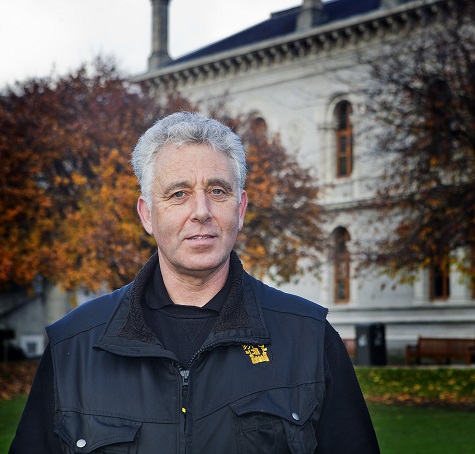
David Hackett, Environmental Services Coordinator with Trinity’s Estates and Facilities Department. Photo Alan Mahon
A past pupil of the National Botanic Gardens and the RHS, David has been working at Trinity College for almost thirty years. David started working in Trinity in 1993 having previously held a position with the local Parks Department, he also has experience with nursery crop management and commercial fruit and veg production. Tony Dalton has been with Trinity for 43 years having worked his way through various sections of E&F before arriving at his current management position in 2012.
John Parnell recently joined Trinity in 2017. He comes here with a 1stHons Level 8 BAgSc (including a stage III scholarship) in Horticulture, Landscape and Sportsturf Management from University College Dublin, graduating in 2008. Previously working in Sportsturf as a Deputy Golf Course superintendent at a private members club, which had formal gardens, grass and synthetic tennis courts along with thousands of trees to maintain, John has also worked in landscaping and has done some part time work with the Irish Sportsturf Research Institute in Wicklow. He is hoping to go back and finish his Masters in Environmental Sustainably when time permits.

John Parnell (left), is Trinity’s Craft Gardener Team Leader and Tony Dalton the Campus Maintenance Manager at Trinity. Photo courtesy Trinity College
The more I spoke to the team about their work at Trinity, the more I realised how much is involved in maintaining the 46 acre site main campus. All of the sites combined measure over 115 acres. My perception of maintaining just a few pitches and lawns quickly disappeared. The team must liaise regularly with the Sports department as they look after all of the fixtures (bookings) on the sports grounds. Maintenance works have to be carefully scheduled in line with the activities booked by Sports Department and other college events. Communication is key between all departments of the college not just E&F for the successful running of the campus and its numerous projects.
On site there is a fibre sand based rugby pitch, a grass hockey and soccer pitch (which, in summer, changes to a cricket outfield and running track to BHAA standard around the perimeter), three artificial tennis courts, a croquet lawn, and hundreds of trees, most of which are mature. There are also 8 sedum roofs, a green wall, a briese soleil (wall), 4 indoor atriums (inc. trees), roof gardens, wildflower meadows along with lots of shrubs, herbaceous planting and the tree collection for the team to maintain and develop. This along with the cleaning and litter maintenance of the Campus keeps the team very busy.
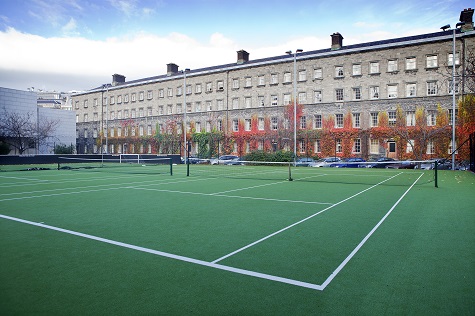
The tennis courts. Photo Alan Mahon
As if that wasn’t enough, there are fifteen off campus sites. These include the college’s 34 acre Sports Grounds in Santry, 3 miles north of the college. The Sports Grounds have undergone significant developments and now boast modern, fit for purpose, state of the art facilities, including three floodlit 3G synthetic pitches, an international standard water-based hockey pitch, soccer pitch, rugby pitch, and a sand based GAA pitch. There are wild meadows in development on site and the site also contains close to 3 hectares of woodland, which has a Tree Preservation Order (TPO).
Estates and Facilities is also charged with managing Trinity Centre sites at two hospitals, St. James’s Hospital and Tallaght University Hospital, along with Islandbridge Boat club, Dartry (student residences and Botanic Gardens). The Trinity Botanic gardens serve as a teaching and research facility for the Trinity College Botany Department. They are maintained by the Botany Department. It is home to a living collection of approximately 4000 species, and houses the Irish Threatened Plant Seedbank.
In 2017 Trinity College Dublin purchased the 17 acre Iveagh Grounds site in Crumlin, from Beverage giants Diageo. Iveagh grounds contains, a sand based GAA/soccer pitch, soil based rugby pitch, an old pitch and putt course, a bowls green, tennis court, an artificial hockey pitch, training areas and a large club house.
There is not enough space to cover everything that Campus Maintenance team do in all the above mentioned facilities so, instead, I will concentrate on the work at Trinity College Dublin main campus for now.
Sports pitches
The hockey, cricket, rugby and soccer pitches lie on one of the oldest sites in Dublin. The land was originally part of the mudflats of the River Liffey. This land was reclaimed where, eventually, All Hallows Priory was built. Even today the flow of the Liffey influences the drainage of some of the pitches. Over the last few years heavy topdressing of College Park has taken place, in line with increased aeration (bi monthly) and overseeding with high quality species. The last 3 years has seen circa 250 – 300 tonnes of sand per year applied. It is also overseeded and vertidrained at the same time. College Park also usually plays host to the Summer Series Concerts, which is a 7 day event and involves covering the Soccer pitch with protective matting and erecting a stage. The Trinity Ball, which is Europe’s largest outdoor party, takes place on site and involves the use of the croquet lawn along with other formal lawns. There are numerous large stage tents erected on site for this event. Logistically being a city centre site, along with the restricted movement around campus, provides a unique challenge to the department.
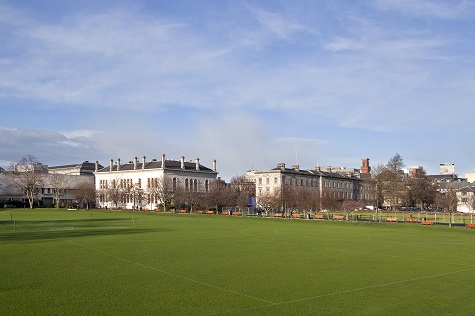
The soccer and cricket pitches. Photo Alan Mahon
The soil under the pitches is naturally rich in Potassium and Phosphorus so the fertiliser applied will have no K or P – usually 46:0:0. The soil PH ranges from 7.8 – 7.9. Soil tests are carried out every year while tissue analysis is done in the alternating years. The soil tests help form the base fertilizer programmes for the sports pitches, liquid feeding, PGR’s are applied as required upon site inspection by John and the External Service Contractor (Sportsworks) who currently hold the contract for the maintenance of College Park.
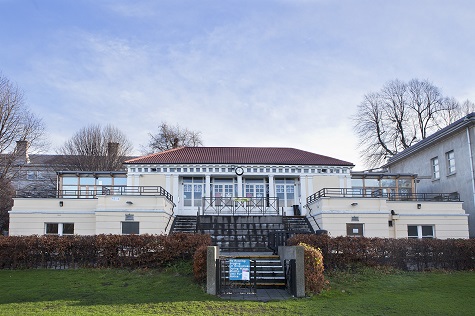
The pavilion. Photo Alan Mahon
The cricket crease has recently undergone full remediation works, which included removing the top layer of rootzone, importing of Binders Ongar loam with 50mm being layered down, levelling compacting and growing in. The remedial works were performed in conjunction with The Trinity Sport, Cricket Leinster and consultant, GM by Choice. It will be a few years before the wicket fully settles down after the remediation works but it is currently in good condition and playing well. The Square was overseeded with MM50 , while the outfield is currently being overseeded with 40% Slender creeping red fescue (Cezanne) 30% Rye grass (Monroe) and 30% Poa pratensis ( Sombrero). The outfield is maintained at 25mm during the winter with height being brought down to 10-12mm for summer use. Wicket preparation for games follows the guidance from GM by Choice and is a 10-12 day prep as recommended by the England & Wales Cricket Board (ECB). A grass running track is provided from April to September around the perimeter of the pitches and is maintained to Business Houses Athletic Association (BHAA) standards. Trinity teams take part in numerous sporting activities at senior and other levels.
There is a fine pavilion on the eastern side of the pitches, which contain the dressing rooms. The pavilion is styled on the cricket pavilion at Lords in England. This pavilion is very eco-friendly. It has solar panels installed for heating and the Pavilion also collects rainwater. In 2019 Trinity College was awarded, for the second time, the Green Flag for environmental management and enhancement. Part of the award was based on the college’s publication of a Pollinator Plan for Trinity in 2017, which commits to reducing pesticide use on campus as well as providing habitat and food for pollinators on Trinity properties.
Covid-19
E&F staff have continued to provide their essential service to the estate during the pandemic as the estate is also a research and residential campus. A new method of delivering this service was developed by E&F by risk assessing and revision of their standard operating procedures in line with the Government Guidelines. The estates has benefited from the decrease in footfall, the horticulture flourished, birds can be heard for all their glory, swifts nesting in the eaves of the Museum Building, the resident squirrels walking among the residents and Trinity’s resident fox (Sam) became a celebrity.
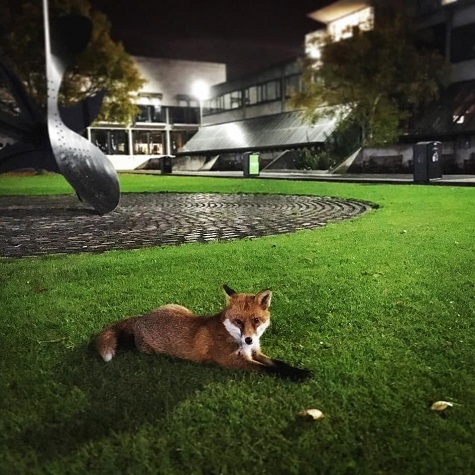
Trinity’s resident fox, Sam, has become a wildlife celebrity. Photo courtesy Trinity College
Trees
There are 432 trees growing on the main campus comprising a wide mix of species brought together from many parts of the world. The trees give character to the college. Some are more than one hundred years old, including two Oriental Planes in New Square, which were planted between 1840 and 1870.

The two Oriental Planes in New Square, planted between 1840 and 1870. Photo Alan Mahon
On the morning of June 2nd 2018, at around 3:00am, disaster struck when one of its much loved trees unexpectedly fell. It was one of the two Oregon maples, which were growing in Library Square and believed to have been planted in 1845 from the first batch of seeds brought back from America by David Douglas (which the Douglas-fir tree is named after) in 1827. Many a graduation photo was taken under this tree. It caught everyone by surprise and when examined it was discovered that the heart wood moisture content of the maple was around 30%, when it should have been at least 90%. This led to serious concerns to the state of the other trees in the college resulting in the second maple in Library Square having to be felled at the same time as its partner as it was found that the cable braces were what was holding some of the main limbs in place. Another Oregon maple growing in New Square was removed within days of the first maple falling. However that tree had already been planned for removal due to a heart wood fungal infection and decay. On foot of this, a seven year research project on the heart wood moisture content of the trees at Trinity began. To date it has been discovered that most of the trees have suffered from reduced moisture content, possibly due to the affects of climate change. This is very worrying, not only for the welfare of the trees, but also to human safety as it can lead to sudden branch drop. The two Oregon maples were replaced in March 2020 by two Gingko biloba trees.
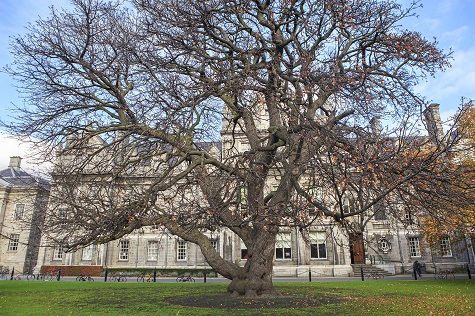
The 175 year old Oregan maple which unexpectedly fell in June 2018. Photo Alan Mahon
Trinity’s main Campus lies on a site of archaeological interest and any work on the ground that involves digging past a depth of 300mm must be supervised by an archaeologist. The reason for this is that the remains of the All Hallows Priory and burial grounds lie directly under the west end of the campus. In 1948 two birch trees were planted, each one in the centre of the two lawns inside the College Green entrance. Both share the same genetic make up and were planted on the same day. 73 years later, one of the trees is much bigger than the other. The reason for this is that the smaller tree is restricted in growth as it is planted over the rubble from the remains of the ancient priory. The taller tree had more fertile ground to grow in and therefore has thrived much better than its sister on the other side of the path. You can see this for yourself should you get the opportunity to visit Trinity College.
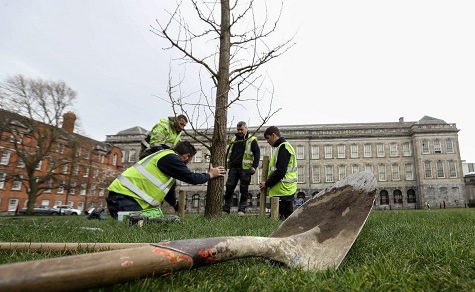
One of the two Ginko Biloba trees being planted to replace the fallen Oregan maples. Photo courtesy Trinity College
The vast majority of trees are deciduous bringing a multitude of challenges, particularly leaf collection and removal during autumn and early winter. Conifers never performed well in the past due to early pollution levels in the city, however as air quality has improved so too have the growth rates on conifers/mosses and lichens on trees, as shown by two studies conducted in the 1990’s and 2018. The team are introducing more conifers now as part of their replacement programme. A new compound has been constructed which allows for collection of leaves by a grab truck, which is then taken off to a green waste recycling facility. Last year around 120 tonnes of leaves and green waste were collected and recycled during the winter months.
E&F have changed over nearly entirely to battery operated equipment and vehicles where possible, this has helped to reduce noise levels and pollution around campus. If petrol or two stroke must be used then ASPEN fuel, which has reduced emissions, fuels the machines.
All-Ireland Pollinator Plan
Trinity College is committed to the All-Ireland Pollinator Plan as well as its own Campus Pollinator Plan. In February 2020 13,850 people took part in a poll overseen by the environmental sustainability advisor and run by the One Step Closer campaign, including those from the college community, asking should the lawns at the College Green entrance to the college be turned into a wild flower meadow. A staggering 12,496 (around 90%) of those that responded were in favour of the idea. The conversion began last summer with the removal of the lawn and was replaced with an Irish wild flora turf mix.
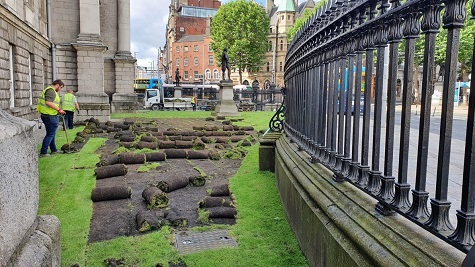
Lifting the turf at the College Green entrance to make way for a wild flower meadow. Photo courtesy Trinity College
By the end of summer, 2020, some annuals began to flower and it is hoped that by this summer some biannual and perennial flowers will make an appearance, along with the seeded annuals coming back up again. Other lawn areas around the college have also been designated wild flower areas.
I now have a different perspective of Trinity College Dublin. When restrictions are lifted and the public can wander around the college grounds again, I look forward to visiting the place. I will look at the pitches, trees and wild meadow areas with a bit more knowledge and appreciation of what goes on behind the scenes. The work they and their staff do to create a wonderful place to relax can sometimes be underestimated.
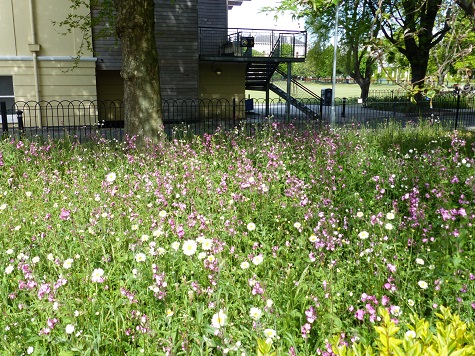
Some of the wild flora established as part of the Campus Pollinator Plan. Photo courtesy Trinity College